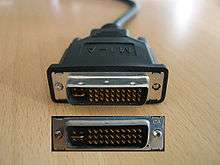VESA Plug and Display

VESA Plug and Display (P&D) is a video connector for digital monitors, such as flat panel displays and video projectors, ratified by VESA. It was introduced around the same time as DFP, marketed as a replacement of VESA Enhanced Video Connector and an extension of DVI. Unlike DVI, it never achieved widespread implementation.
The P&D connector shares the pin layout of VESA EVC, but the pins assigned for carrying analogue audio and video in signals are reused to carry digital video signals.
Signals
A basic P&D line carries single-link TMDS digital video signal (max 160 MHz), and supports VESA Display Data Channel version 2.
Analogue video signals, if supported, must be capable of carrying at least 150 MHz bandwidth.
USB version is not specified, but if supported, it would have been intended for contemporary USB standards. The USB connector is intended for passing mouse movements from a projector's wireless remote into the computer's presentation software.
Firewire, if supported, must be compliant to IEEE 1394-1995 specification.
Connectors
Although the pin layout comes from VESA EVC, the connector shell is slightly different. P&D-A/D is compatible with EVC device (except for the missing VESA EVC features), P&D-D is not.
In addition to the regular P&D connector, the standard also specifies a 40-pin microribbon connector, which is only defined when making digital video connection.
Articles such as those from The Register sometimes mistake the P&D port as an alternative form of the Apple Display Connector,[1] but ADC carries higher current, has different pin layout, and does not support FireWire.
Alternative names
- M1-DA, a name used by InFocus (often shortened to M1)